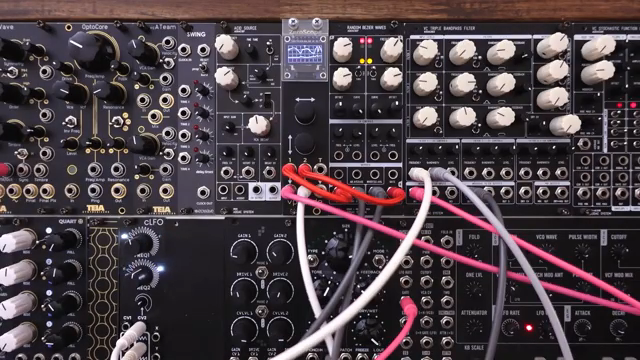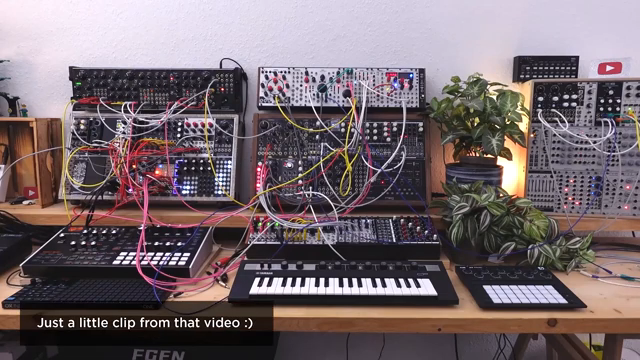MonotrailTechTalk dives into the wonderful chaos of modular synths in this video, revealing three nifty tricks your regular standalone synth just can’t do. It’s all about the tools that bring modular setups to life, making them a must-watch for anyone eager to elevate their patching game. Grab a pint, sit back, and let Monotrail show you what your synth setup might be missing.

23. October 2025
JET
MonotrailTechTalk’s Modular Madness: Three Tricks You Can’t Ignore
ADAC Intuitive Quantizer, Derpfer A156, Dobefer A162, Mutable Instruments Peaks
The Clock Divider Conundrum
MonotrailTechTalk starts by singing the praises of the clock divider—an often overlooked gem that adds dynamic rhythms to your modular setup. With a clock divider like the Dobefer A162, the palette of rhythmic possibilities multiplies faster than rabbits in springtime. Most standalone synths don’t come with this feature, which is a shame because the uneven divisions create mesmerizing patterns that breathe life into even the simplest patches. You can’t help but marvel at how a mundane piece of gear injects such intricate modulation into daily soundscapes.
The creator loves pairing it with modules like Chaos Devices Erfurt and Lipsk, crafting complex patterns that would make any synth enthusiast drool. By using a combination of different divisions, Monotrail offers up tricks for sequencing that redefine how a melody flows. A divide by 7 might drive a sequence, while a divide by 13 modulates a filter—blowing past the limitations of traditional setups. Who needs a high-end synth when a clever use of clock divisions can serve up such rich textures?
It’s clear these tools aren’t just for show. The video elaborates on how clock dividers function as both modulation sources and sequencers. Such devices go beyond mere rhythm makers, transforming into core modulation machinery that can gel several functions into one harmonious chaos. “Generative and self-playing patches,” Monotrail says, are where this tool truly shines. Making clock dividers a permanent fixture in your modular rig could elevate even the most humble audio concoction into auditory art.

"A clock divider is a simple tool, but I remember when I got my first one. It changed how I patched and thought of modular signal flow."
Smooth Random Voltages: A Wild Ride

"But to the point, for me random voltages are the thing that breathes life into everything from a tiny simple voice to complex generative setups."
Monotrail shifts gears to discuss the power of smooth random voltages. Unlike stepped variations that some synths offer, these smooth flows breathe an unpredictable life into a setup. He recalls the early days with modules like Mutable Instruments Peaks, which provided dual smooth random voltage generators—a nod to Monotrail’s foundational modular experiences.
These voltages add a layer of human unpredictability to the sterile, predictable sequences. In the hands of an adept patcher, they turn static oscillations into living, breathing entities. It’s fascinating to see this idea brought to life: simple voices burgeon into something truly extraordinary with just a hint of randomness.
Monotrail highlights how these voltages can animate anything from a basic oscillator to a wave folder. Two sine waves become a symphony once a smooth random voltage modulates their journey. Think of it as taking a leisurely stroll through a chaotic wonderland, where no two steps—or notes—are ever the same. Monotrail’s design ethos for his module is clear: make random accessible yet deeply expressive. No surprise that this tool became a pillar in his creative arsenal.
Quantizers: The Unsung Heroes
Finally, Monotrail champions quantizers—often skipped by those focused solely on standalone synths. Derpfer A156 makes another appearance, a staple in his setup for its practicality and fun. This module acts like that mate in a pub who always has your back—reliable and full of pleasant surprises. Quantizers in modular synths are builders and tamers of chaos, molding signals into melodic sequences that standalone gear struggles to replicate.
Monotrail’s voice brims with enthusiasm as they demonstrate how dual and quad quantizers elevate entire setups. The ADAC Intuitive Quantizer offers a fancier touch, enabling chord creation from single inputs. Such an intricate level of control opens doors to polyphonic escapades previously reserved for more expensive gear.
For Monotrail, a quantizer is the foundation upon which musical complexity is built. Whether it’s feeding them layered signals for unpredictable compositions or honing them to craft solitary voices, they’re indispensable. It’s a game-changer for those who crave something extra, a device that transforms modular rig into an orchestra of possibilities.
The Trinity of Modular Magic
Wrapping things up, Monotrail summarises the holy trinity that consists of clock dividers, smooth random voltages, and quantizers. Each tool has the potential to turn a modular setup into a vibrant playground where experimentation knows no bounds. These elements create interactions that defy the capacity of traditional synthesizers, making them indispensable for those seeking to push boundaries.
Monotrail acknowledges the unique role each component plays in daily jam sessions. Whether he’s patching just to pass the time or diving deep into creative experiments, these tools form the backbone of endless auditory exploration. He invites viewers to ponder what features make their modular setups uniquely fun, encouraging them to share their insights in the comments.
By melding simple concepts with refined techniques, Monotrail takes us beyond a mere demonstration of gear. Instead, he crafts a narrative of exploration and limitless potential, asking us to consider not just the sounds we make but how we make them. His insights remind us why modular synthesis remains a captivating art form—even amidst the convenience of standalone synths.

"As you might have noticed these three elements aren't random. They are a great trinity that make me enjoy the modular on daily basis."